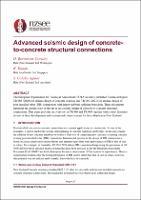Advanced seismic design of concrete-to-concrete structural connections

Download
Date
2023-04-19Authors
Borosnyoi-Crawley, Dorian
Kundu, Kamalika
Caloba-Aguiar, Samuel
Metadata
Show full item recordAbstract
Seismic strengthening of concrete buildings and bridges may require the addition of new concrete members or overlays. One way of connecting new concrete to existing concrete is using post-installed rebar (PIR) connections. International practice in the design of PIR connections is based on classic theory that assumes equivalent bond performance of PIR in comparison to cast-in rebars. For example, in Australia, AS 5216:2021 allows PIR connection design by the provisions of AS 3600:2018 for those injection mortar systems which were assessed by the European Assessment Document EAD 330087 and hold a European Technical Assessment (ETA) as proof of equivalence.
There is experimental evidence that the bond performance of PIR can be much better than that of cast-in rebars. However, this potential was not utilized until recently, due to the lack of standards.
The European Organization for Technical Assessment (EOTA) recently published Technical Reports TR 066 (2020) and TR 069 (2021) for seismic design of concrete overlays and seismic design of PIR connections with improved bond-splitting behaviour. These documents represent the current state-of-the-art in the seismic design of concrete-to-concrete structural connections.
EOTA TR 066 and TR 069 has great relevance in the New Zealand practice and the adoption of these documents would be beneficial. This paper provides an overview of the TR 066 and TR 069 methods together with a literature review of their development. The paper provides comparisons with the methods of NZS 3101 and recommends future actions for the adoption of TR 066 and TR 069 in New Zealand.
